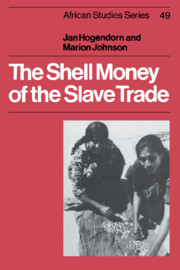Book contents
- Frontmatter
- Contents
- Maps
- Tables and chart
- Preface
- Introduction
- 1 The cowrie
- 2 The Maldive Islands
- 3 The Portuguese domination
- 4 The Dutch and English enter the trade (seventeenth century)
- 5 Prosperity for the cowrie commerce (eighteenth century)
- 6 Boom and slump for the cowrie trade (nineteenth century)
- 7 Collection, transport and distribution
- 8 Cowries in Africa
- 9 The cowrie as money: transport costs, values and inflation
- 10 The last of the cowrie
- Notes
- Bibliogaphy
- Index
Introduction
Published online by Cambridge University Press: 12 October 2009
- Frontmatter
- Contents
- Maps
- Tables and chart
- Preface
- Introduction
- 1 The cowrie
- 2 The Maldive Islands
- 3 The Portuguese domination
- 4 The Dutch and English enter the trade (seventeenth century)
- 5 Prosperity for the cowrie commerce (eighteenth century)
- 6 Boom and slump for the cowrie trade (nineteenth century)
- 7 Collection, transport and distribution
- 8 Cowries in Africa
- 9 The cowrie as money: transport costs, values and inflation
- 10 The last of the cowrie
- Notes
- Bibliogaphy
- Index
Summary
The shell money of the slave trade consisted of thousands of millions of little cowrie shells, most of them fished in the lagoons of the far-off Maldive Islands of the Indian Ocean. They came to West Africa in a journey lasting a year or more, shipped initially by Arab merchants who took them to North Africa for export across the Sahara, and later by the European trading companies who carried them to Lisbon, Amsterdam, or London as ballast. Thence they were shipped by the barrel-load to the West African coast, where they were an indispensable currency before, during, and after the slave trade, in purely quantitative terms overshadowing all others.
Of all the so-called “primitive moneys,” this cowrie currency of West Africa (and parts of Asia as well, although that is not our focus) is arguably the most important, the most interesting, and the most modern. Cowrie-money was not really primitive at all. It seems so only to eyes grown so familiar to dates, faces, and nationalities stamped on coins that they can conceive of no alternative. It was a “general-purpose money” that served as medium of exchange, unit of account, store of value, and standard for deferred payment. For a very long period of time, the shells were actually better suited to transactions of extremely low value than were metallic coins, because it was all but impossible to mint a coin with worth as low as an individual cowrie.
- Type
- Chapter
- Information
- The Shell Money of the Slave Trade , pp. 1 - 4Publisher: Cambridge University PressPrint publication year: 1986

